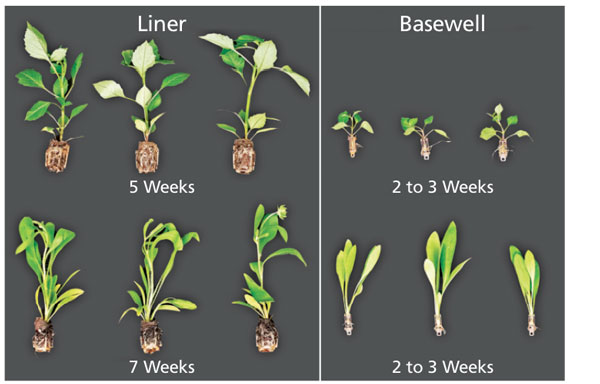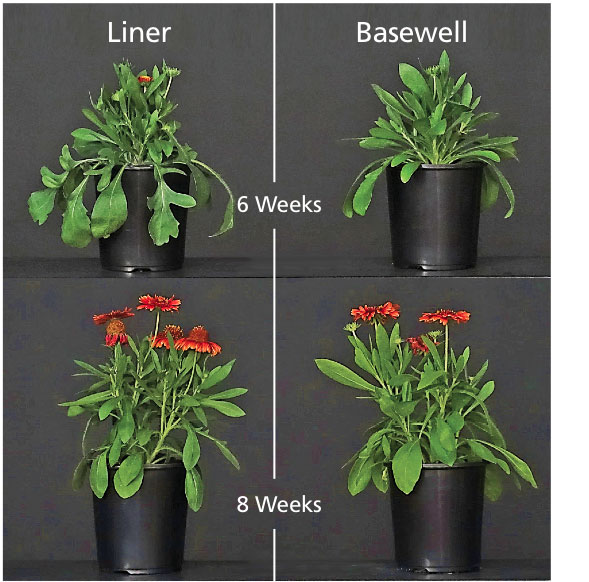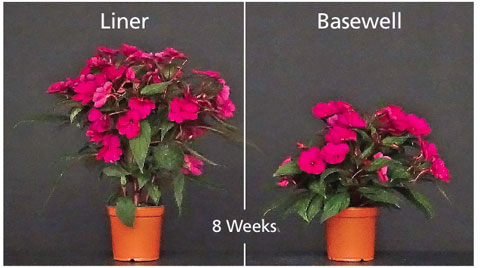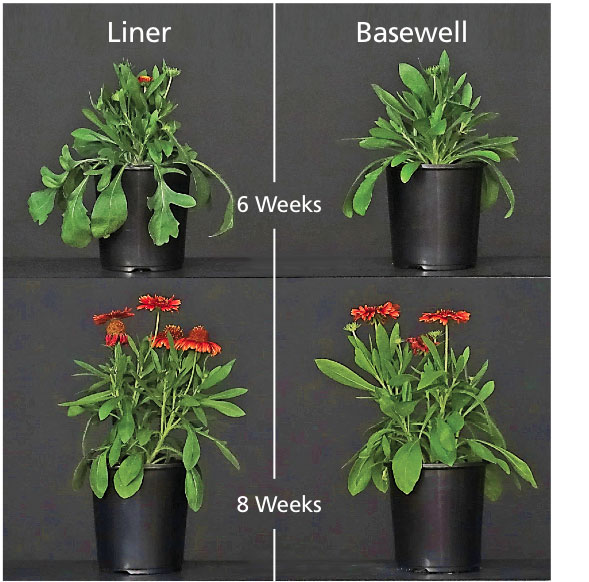3/1/2022
A Study of the Latest Young Plant Technology
Annika Kohler & Roberto Lopez



 Basewell cuttings by Dümmen Orange have been on the market for the past few years. According to Debbie Rempert, Dümmen Orange’s Senior Brand Manager, they were developed to speed up the propagation process, and ultimately, finished production time of annuals and perennials. She adds that the rooted cuttings provide growers with a head start, similar to a rooted liner, by eliminating the challenging stages 1 and 2 of propagation. At the same time, they allow greenhouse growers to benefit from lower off-shore propagation costs, reduced freight compared to rooted liners, faster transplanting as the rooted cuttings can be directly stuck into the finished container, and savings on labor costs.
Basewell cuttings by Dümmen Orange have been on the market for the past few years. According to Debbie Rempert, Dümmen Orange’s Senior Brand Manager, they were developed to speed up the propagation process, and ultimately, finished production time of annuals and perennials. She adds that the rooted cuttings provide growers with a head start, similar to a rooted liner, by eliminating the challenging stages 1 and 2 of propagation. At the same time, they allow greenhouse growers to benefit from lower off-shore propagation costs, reduced freight compared to rooted liners, faster transplanting as the rooted cuttings can be directly stuck into the finished container, and savings on labor costs.
Figure 1. Liners and rooted Basewell cuttings of Dahlia Hypnotica Lavender (top) and Gaillardia SpinTop Yellow Touch (bottom) upon receiving.
The difference between the Basewell cutting form versus traditional unrooted cuttings (URC), callused cuttings and rooted liners is that each cutting has a developed root system without shipping growing media, thus allowing for off-shore propagation that’s authorized to ship into North America. Additionally, Basewell cuttings are available in two configurations, including full strips of biodegradable cartridges for automated production methods, as well as individual units compatible with non-automated production environments where workers can quickly transplant the product by hand, similar to transplanting a rooted liner into the finished container.
Given that one of our research areas is propagation of herbaceous crops, we’ve received many inquiries from greenhouse growers about this new bareroot technology. Therefore, last summer, we conducted a trial to compare how rooted Basewell cuttings performed and finished against traditional liners produced by rooting stations.
Figure 2. Dahlia Hypnotica Lavender after six weeks (top) and eight weeks (bottom) post-transplant.
The trial
Annual Coleus Main Street Beale Street (Coleus blumei), Dahlia Hypnotica Lavender (Dahlia hybrida), New Guinea Impatiens SunStanding Apollo Purple (Impatiens hawkeri), and perennial Coreopsis Leading Lady Lauren (Coreopsis auriculata), Gaillardia SpinTop Yellow Touch (Gaillardia aristata), Gaura Graceful Light Pink (Gaura lindeimeri), Leucanthemum Sweet Daisy Birdy (Leucanthemum maximum), and Phlox Flame Purple Eye (Phlox paniculata) were received as rooted Basewell cuttings or as traditional rooted cutting liners (control) from a commercial grower (Figure 1).
Figure 3. New Guinea Impatiens SunStanding Apollo Purple after eight weeks post-transplant.
The traditional annual and perennial liners were five and seven weeks from stick, respectively, whereas the Basewell cuttings ranged from two to three weeks from stick. Upon arrival, annuals were transplanted into quart containers and perennials into trade gallon containers that were filled with a soilless commercial substrate formulated for annuals or perennials. Given that the study was conducted during the summer, Basewell cuttings were placed temporarily in a propagation house to receive intervals of overhead mist and acclimate to greenhouse conditions for three to seven days depending on the genera.
Figure 4. Gaillardia SpinTop Yellow Touch at six weeks (top) and eight weeks (bottom) post-transplant.
All plants were finished under a natural photoperiod in a glass-glazed greenhouse that had a layer of whitewash. The daily light integral and average daily temperature were 14.5 mol•m–2•d–1 and 74F (23C), respectively, over the course of the study.
For all five replications, control plants (traditional liners) of gaura, gaillardia and coleus were pinched and rooted Basewell cuttings were left unpinched. With the exception of coleus and New Guinea impatiens, control liners received rooting hormone at the rooting station, while Basewell cuttings did not.
For each replication, stem length and caliper, and root and shoot dry mass were measured for each plant. During finished production, the date of marketability (which was when the plant filled the circumference of the container) was well-rooted and 50% flowering, along with plant height and width were measured.
What we found
Due to the difference in maturity of the Basewell cuttings and the control for all genera, the Basewell cuttings were 37% to 85% shorter, had 12% to 51% smaller or equally sized stem caliper, and had a 69% to 94% and 47% to 91% smaller root and shoot dry mass, respectively, than the traditional liners.
For finished plants, time to marketability varied among genera. For instance, both Basewell and control gaura were marketable within 45 days (six weeks) from transplant. However, most Basewell plants took slightly longer to become marketable, with Basewell phlox taking 3.5 weeks to reach marketability from transplant compared to the control.
With the exception of coleus, coreopsis and New Guinea impatiens (Figure 3), plant height and width were similar once marketability was met. Basewell New Guinea impatiens and coreopsis were more compact at marketability than the control. Basewell coleus was 10% wider at marketability than the control.
When taking into account that annual and perennial Basewell rooted cuttings were two to three and four to five weeks younger, respectively, than the traditional liners, time to marketability and overall production time was shortened, but it varied between genera.
For instance, using a Basewell dahlia rooted cutting only saved four days of production time (young and finish plant stages combined), whereas Basewell gaillardia rooted cuttings can save four weeks (Figures 2 and 4). The majority of the rooted Basewell genera that were utilized in this study led to a reduction of two to five weeks of propagation. However, under our environmental and cultural conditions, the Basewell cuttings had to be placed in a propagation environment, as they began to severely wilt and needed a combination of overhead mist, foggers and retractable shading for at least five days to acclimate after transplant.
Due to the slight difference in time to produce a marketable plant and the added benefit of reduced propagation time, rooted Basewell cuttings are a viable option to implement when adequate care is taken upon transplant. GT
Acknowledgements: We thank Dümmen Orange for plant material and containers, and Raker-Roberta’s Young Plants for liners. We also thank the team at Dümmen Orange for trial coordination and Nate DuRussel for greenhouse assistance. The use of trade names in this publication does not imply endorsement by Michigan State University of products named nor criticism of similar ones not mentioned.
Annika Kohler is a Research Technician and Roberto Lopez is an Associate Professor and Controlled Environment/Floriculture Extension Specialist in the Department of Horticulture at Michigan State University.